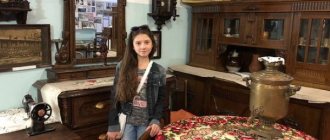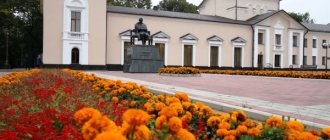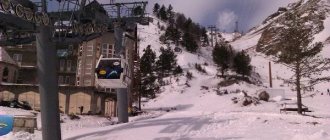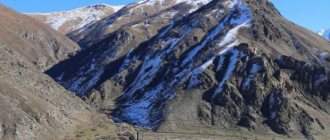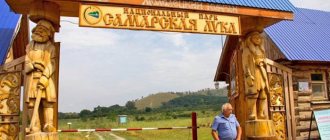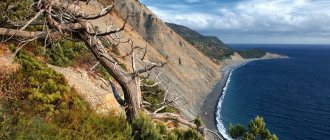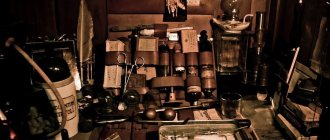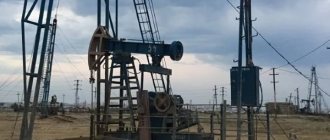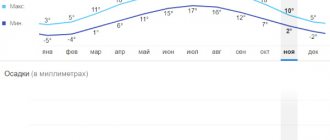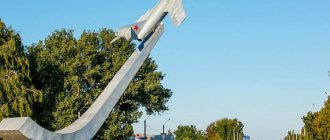Tatyana Afanasyeva
Arriving in Minvody, we rented a car and drove 1257 km in Stavropol, Karachay-Cherkessia and Kabardino-Balkaria. If you missed the beginning of the series, everything is in the links, and we move on.
If you missed the beginning of the series, everything is in the links, and we move on.
Part 1. Departure from Kaluga, domestic car rental, Bermamyt and Kislovodsk. Part 2. Dombay, the Devil's Mill, the site of Pechorin's duel and the climbers' cemetery.
Part 3. Djily-Su, Narzan Valley and abandoned castle
— Let me remind you what the entire route looked like.
The importance of the city in the modern world
Chegem is located in the central part of the Kabardino-Balkarian Republic, just 3 km from the capital - Nalchik, being, in fact, its suburb. It received its name from the name of the river on the right bank of which it is located.
On the other bank there is a village called “Chegem the Second”, which has an independent status, but is in fact a continuation of “Chegem the First”: they have a common border running along the river, and a common history of education and development. 40 km from Chegem, in the valley of the Chegem Gorge there is the village of “Chegem Nizhny”, and in the mountains, at an altitude of 1.7 km - “Chegem Upper”.
All Chegems are connected among themselves not only by a mountain river formed in the glaciers of the North Caucasus. Geographically, they belong to the Chegem region of the republic and are a tourism and recreation area for residents and guests of Kabardino-Balkaria.
People have settled at the foot of the mountains since very ancient times. Burial sites in the form of burial mounds and archaeological artifacts found in abundance on the Chegem River are confidently attributed by experts to the 14th-16th centuries. The settlement, which became the regional center, appeared a little later.
Its founder is considered to be the former serf Islam Mambetov, who received his freedom from the commander of the Russian troops in the Caucasus, Alexei Petrovich Ermolov, who built many fortresses in these places, including Nalchik. Mambetov continued his service, being an assistant to the Kundetov princes, the owners of this land.
As a sign of encouragement, the princes allocated him a plot of land on the right bank, where Islam built a house for himself and moved his entire family to live. The new village, which appeared in 1822, was named according to local custom after the prince-owner - Kundetov. It became Chegem after the revolution, renamed in 1920 as the bearer of the princely name.
During the Second World War, the village was in the hands of the Nazis for 3 months; it was liberated simultaneously with Nalchik in January 1943. The city honors and remembers the names of the victims. Chegem First became a city only in 2000, its area is 73 km2, and its coordinates are 43°34′00″ N. w. 43°35′00″ E. d.
Gorge
From the Chegem waterfalls it’s almost an hour’s drive to the upper reaches of the gorge, to Upper Chegem. Beyond the gorge, where the Chegem waterfalls are located, the gorge widens, forming more gentle slopes. The road goes along the left bank of the Chegem and soon reaches an area called Ak-toprak (from Balkar - White clay).
There are simply stunning views through the windshield ahead, but there is no way to take a photo. You have to catch rare moments of beauty on the starboard side.
The weather in the Chegem Gorge is slowly deteriorating, the sky is getting darker. Korgashiklitau (3813 m.) all in the clouds.
Climate
In the Chegem region, the climate is not the same everywhere; it is determined, first of all, by the terrain and depends on the altitude above sea level. Chegem is a city that is located in the foothill zone and has typical climatic conditions: there are no strong winds, daily fluctuations in air temperature are significant, its average annual value is + 9.5 0C.
Spring comes early and quickly turns into summer; already in mid-April the thermometer can show 30 degrees. Summer is hot and lasts until the end of September; light breezes from the mountains bring relief from the heat. Autumn is long, warm and dry. Winter is mild, almost snowless.
Chegem, weather by month.
Daily air temperature (0C), precipitation (mm), number of sunny days in Chegem:
| Jan. | Feb. | March | Apr. | May | June | July | Aug. | Sep. | Oct. | Nov. | Dec. |
| -3 | +3 | +12 | +14 | +22 | +26 | +28 | +29 | +20 | +11 | +6 | +3 |
| 15 | 9 | 36 | 46 | 111 | 133 | 95 | 70 | 56 | 25 | 20 | 25 |
| 16 | 15 | 15 | 17 | 22 | 22 | 22 | 23 | 21 | 21 | 20 | 20 |
Lower and Upper Chegem are areas of tourist travel. They are distinguished by a mountainous climate, becoming increasingly harsh as they rise in altitude. On the peaks of the Rocky Range there is eternal snow with glaciers.
Paragliding
The mountain parade deserves special attention. The paragliding site is located 17 km from the waterfalls. It is surrounded on all sides by mountains, which creates optimal weather conditions for a comfortable flight. From the end of March to November, in clear weather, dozens of extreme sports enthusiasts flock to the parade ground. For them there is a very comfortable campsite with a kitchen, bathhouse, cafe and other amenities.
Even if you don't want to take off, this place is worth a visit just for the beautiful spectacle. Paragliders soaring at dizzying heights against the backdrop of stunning mountains will remain a pleasant and romantic memory.
© Natalia Semchina
Flora and fauna
The flora and fauna of the surrounding area of Chegem corresponds to the diversity of landscapes. Mountain rivers, descending from glaciers, feed alpine meadows and agricultural lands. The herbs of the meadows are not only decoration, they are pastures for livestock, which are raised here for domestic consumption and export.
The mountain slopes and foothills are the territory of forests, consisting mainly of beech and hornbeam. The unique natural conditions made it possible for plants that can only be found in these places to take root here. The high-mountainous Kabardino-Balkarian Nature Reserve, home to more than 300 species of birds and 60 species of amphibians, is engaged in the protection and conservation of local flora and fauna.
Day 5. Turist Peak (2450 m)
The way back towards the camp site. Let's take a stroll, there will be an opportunity to take a lot of beautiful photos. We will visit Tourist Peak (2450 m). We spend the night in tents.
Length 7 km
How to get there
The main mode of transport in the republic is automobile. The federal highway R-217 “Caucasus” passes through Chegem, connecting the city with all Caucasian and Russian settlements.
Chegem and Nalchik, located 3 km from each other, are connected by 5 public transport routes. Passenger minibuses "Gazelle" ply along them. Their opening hours are from 6-00 to 23-30.
The capital of the republic is a transport hub connecting Kabardino-Balkaria with cities in Russia and abroad. Every day, the Elbrus train departs from Paveletsky Station in Moscow to Nalchik, arriving at the final station after 36 hours. Ticket price – from 3 thousand rubles. (if purchased early).
Along the way, the train makes many stops, including:
- Lipetsk;
- Voronezh;
- Rossoshi;
- Rostov-on-Don;
- Mineral waters.
Electric trains run to the cities of Prokhladny (junction station) and Mineralnye Vody. Nalchik International Airport receives regular flights from Moscow and St. Petersburg, where planes and Pobeda fly. Travel time is 2.5 hours, ticket price is from 2,700 rubles.
Notes
- ↑ 12
www.gks.ru/free_doc/doc_2016/bul_dr/mun_obr2016.rar Population of the Russian Federation by municipalities as of January 1, 2016 - webgeo.ru/db/1959/rus-assr.htm All-Union Population Census of 1959
- webgeo.ru/db/1970/rus-kavkaz.htm 1970 USSR Population Census. RSFSR - North Caucasus region
- webgeo.ru/db/1979/rus-kavkaz.htm 1979 USSR Population Census. RSFSR - North Caucasus region
Etoko • Zalukokoazhe • Psynadakha • Malka • Kuba-Taba • Islamey • Baksan • Dugulubgey • Chegem Second • Chegem • Nalchik • Urvan • Old Cherek • Argudan • Anzorey • Khatuey
Religious buildings of the city and surrounding areas
Mosque of the city of Chegem, located at the address: st. Lenina, 42, is currently under reconstruction. Another one is on the same street, at house 161. Many religious citizens visit Nalchik mosques.
Central Mosque of Kabardino-Balkaria (Nalchik)
The Nalchik Cathedral Mosque is located on Shogentsukov Avenue, 41. Its opening took place in 2004, construction work lasted 4 years. The project by architect A. Asanov was rated as the best in a competition organized by the city authorities. Local materials were widely used in the decoration of the building. The height of the single-dome structure is 21 m, the total area is 1700 m2.
Two tall minaret towers complete the complex.
The building has two floors: the first is square in plan. There are wardrobes, ablution rooms, and separate halls for men and women; in the far corner is the women's prayer hall. The second floor, built in the shape of an octagon, is a prayer hall for men. The presence of two entrances, for parishioners and clergy, also corresponds to the canons of Islam.
Museums
Chegem is a city with one museum. Everyone is willingly invited here to get acquainted with the life and work of the famous fellow villager. Tourists seeking to gain more knowledge about the republic visit Nalchik museums.
Memorial House-Museum of Kaisyn Shuvaevich Kuliev (Chegem)
Every day in Chegem on K. Kuliev Street, 21, except Sunday and Monday, there is a museum of the Balkar poet, who lived in the house where the exhibition is displayed today. He spent the last period of his life here, wrote many works, many of which he dedicated to the Caucasus and its inhabitants. Here the poet died, bequeathing to bury himself near his beloved house.
His grave is located on the territory of the museum. The first half of the exhibition tells in chronological order about the events in the life of K.Sh. Kulieva, the second - demonstrates the furnishings of the last years of his life: office, bedroom, living room, outbuilding. The creation of the exhibition involves the poet’s personal belongings, his books, manuscripts, and photographs.
National Museum of the Kabardino-Balkarian Republic (Nalchik)
The museum, where visitors learn everything about the geographical location, terrain, mining in the republic, as well as its flora and fauna, has been operating since 1921. Much attention is paid here to the history of indigenous peoples, their culture, traditions, and ethnography.
Today, museum workers have a fund of 50 thousand items at their disposal. storage, with the help of which permanent exhibitions and temporary exhibitions are created. Museum address: st. Gorkogo, 62. Ticket price – 50 rubles.
Natural attractions
The Caucasus Mountains themselves are a precious, extraordinarily beautiful and generous attraction. It is not for nothing that many sanatoriums, holiday homes, and sports centers have been built in the mountains and valleys. The Chegem region has unique natural values, which are located in close proximity to the district center.
Chegem River
The Chegem River, which originates in the Bashil glacier, which is located north of Elbrus, and which has given its name to many geographical objects, is worthy of a separate description. It makes its entire 103 km journey to the confluence with the Baksan River through the mountains, winds through a narrow canyon, jumps from a height, and when it reaches the plain, it divides into two streams, which later merge again. And all this at great speed.
Its main natural attractions are the Chegem Canyon and Chegem Waterfalls. However, its largest and most spectacular waterfall is inaccessible to ordinary tourists. It is located in the high mountain zone, where Chegem is called Bashil-Auzusu by the locals. The 78-meter single water jump “Abai-Su” can only be seen by trained climbers.
Chegem Gorge
The winding and deep gorge of Chegem is located 40 km from the city and is the most beautiful and popular tourist attraction in the region. The road to the Chegem Gorge goes past the village of Chegem Vtoroy, other Kabardian settlements, along the river, which has already broken free and flows quickly across the plain.
After the village of Lechinkai the highway begins to cut into a still wide passage formed by mountains growing in height. The village of Nizhny Chegem remains on the right bank. The road continues to go along the bottom of the canyon for some time, while the rocks rise higher and higher. Now they are already hanging over travelers at a height of 300 meters, getting closer to 15-20 m.
The river, compressed on both sides, resisting the onslaught of stones, rushes with a roar from side to side, bending around the obstacles created. This is the 3-kilometer Chegem Gorge, a narrow gap cut by a river in the Rocky Range mountain range. Local legends claim that the mountain parted not under the influence of a stream of water, but from the blow of the hooves of the horse of a mountain hero.
The mountain slopes, where the sun can reach, are covered with greenery: beech and hornbeam forests interspersed with wild fruit trees, berry bushes of barberry, dogwood, and sea buckthorn.
The sun's rays reach the bottom of the gorge for about 3 hours a day, and it is gloomy and bare here. The cliffs with lonely pine trees clinging to the eaves and the roaring river make a strong impression. Filmmakers often choose the picturesque Chegem Gorge as a platform for their work. “Sannikov Land”, “Hero of Our Time”, “War” and others were filmed here.
Chegem waterfalls
Chegem waterfalls are 3 groups of falls that form the Chegem and its tributaries. The picture resembles a fantastic, branched tree. The first of them is “Adai-Su” (“Maiden’s Spit”), which is located not on the Chegem itself, but on a tributary.
To see it, you need to move 150 meters away from the main road. Nature has created a 30-meter stone trench along which water “rolls down.” This is a Small waterfall, but it is the strongest.
The second fall is a whole group called Big Waterfalls:
- “Sakal-Tup” is located on the right tributary of the Chegem, it also “rolls” along a natural gutter.
- The main waterfall is where the next tributary flows into the Chegem. Part of the stream “jumps” in a cascade from a height of 50-60 m, and part of it oozes along the walls, rolling down, sometimes in streams, sometimes as a continuous curtain into the main river. When struck by stones, the streams break into chaotically scattered splashes and water dust. This waterfall always shimmers with all the rainbow colors in sunny weather.
In winter, the waterfalls do not freeze; excursions are organized here all year round.
Fly Chegem Park
The Paradrome is one of the sites of the Fly Chegem extreme park. In addition to flights, they organize jumps from a height of 50 meters (rope jumping), zip-line rides, horseback riding, ATV rides, excursions to the eco-farm, the Upper Chegem ethnographic park and other places.
Prices for services of the extreme park Fly Chegem on the official website
Park camping, © Natalia Semchina
Monuments
Chegem is a city that actively participates in the life of the republic and the country. Those who fell during the Second World War while defending the Fatherland are given special honors here. There are modest monuments, marble plaques or memorials in every village.
Monument-memorial to fallen soldiers (Chegem)
On Sovetskaya Street, in a small well-kept square located in the city center, a memorial was erected in honor of the soldiers who died in the fight against the fascist invaders. The complex includes a tall snow-white stele with a star at the top and a sculptural composition consisting of two figures. On both sides of the stele are victorious soldiers. But their poses express bitterness and sorrow for their fallen comrades.
One warrior lowered his bare head low, and the second took a knee, saying goodbye to his fallen colleagues. The sculptural group is located on a raised platform, with three steps leading to the upper platform. In front of the composition is a bowl of eternal fire.
Bas-relief of Vladimir Ilyich Lenin (Chegem)
The monument was erected in the 60s of the last century on the street. Baksan highway, opposite the city administration building. On the front side of a 3-meter white stone block is carved the head of the leader of the world proletariat V.I. Lenin. He knits his eyebrows and looks sternly into the distance.
The remaining edges of the stone remained natural, untreated. Being on an embankment, the work looks even more powerful. The monument is recognized as a work of monumental art of the Soviet era in the postmodern style.
Excursions
Travel companies in Nalchik offer excursion trips to the most picturesque places of Kabardino-Balkaria.
| Tour operator, contacts | The name of the program | Description | Cost, rub. |
| Tourist st. Keshokova, 102, office 7 7 | "Weekend in Chegem" | Visit to the Chegem Gorge with an overnight stay by the fire. The program includes: acquaintance with the gorge, the river and its tributaries, the ancient Settlement with crypts, and the ruins of temples. | 1500 |
| "Blue Lakes" | Visit to the Chegem Gorge and the karst Blue Lakes - the deepest in the North Caucasus with a water temperature of 9.6 degrees all year round. | 750 | |
| "Towers of Balkaria" | A trip to the Blue Lakes, to the Cherek Gorge, to the village of Upper Balkatia with its ancient sights. | 1300 |
Economy
The city is mainly developed in the sphere of sales and services. Small and medium-sized businesses are developing rapidly. In recent years, the area allocated for growing fruit trees and greenhouse complexes has increased significantly.
The largest enterprises in the city are:
- LLC "Greenhouse complex "Chegem" is one of the largest greenhouse complexes in the North Caucasus.
- Asterra LLC
- LLC "Kamad"
- Chegemvinpischeprom LLC
- Boren LLC
- Karista LLC
Route for exploring the city on your own in 1 day
Chegem can be seen in 1 hour. This time is quite enough to get acquainted with the few sights of the city. Next, if you have your own vehicle, you need to go to the mountains and explore the natural scenic sites of the region. This will take the rest of the day. There are roadside cafes along the road and in the mountains where you can have a snack.
If there is no transport, then you will have to organize your day something like this:
- go to Nalchik by public transport;
- purchase a ticket for an excursion trip to the mountains (some daily excursions begin in the afternoon);
- walk the streets of Nalchik, its resort and pedestrian zone, buy souvenirs;
- get acquainted with the exhibition of the local history museum;
- have lunch in a city cafe;
- go with a group on a trip to the mountainous region of the Chegem region.
If the trip to the mountains takes place in the morning, then exploring Nalchik is postponed until the evening. But it’s better to book an excursion ticket in advance by phone or via the Internet in order to better know your daily routine.
Day 3. Radial exit to the “Martian” Kumtyube plateau
Let's make a radial exit to the plateau. We will overcome the pass and find ourselves in a very unusual place - the Kumtyube plateau. Our view will be of extinct volcanoes - Kumtyube and Kumkyugenkaya, two Kum lakes feeding the Abai-Su waterfall, and other impressive panoramas. On Mount Kestantytau, many of us will set a personal altitude record - the height of the mountain is 3774 m. At its top there are weathering pillars - unusual, mushroom-like monuments. These views will give us great souvenir photos!
Length 14 km. Elevation gain 700 m
Hotels
A huge selection of hotels, mini-hotels, guest houses and hostels is available in nearby Nalchik. There is a sufficient choice of housing in the settlements of Chegem Nizhny and Chegem Verkhny, which are the destination of tourist trips. There is 1 hotel in the city of Chegem.
Hotel (Chegem)
At the address: st. Kulieva, 12 you can book a room with breakfast, free internet and parking. The room is equipped with beds; The shared toilet is located in the corridor. The cost of a double room is 1000 rubles.
Hostel "Teplichny" (Nalchik)
The hostel is located between Nalchik and Chegem at the address: st. Gasovaya, 12.
Here guests are offered 4-6-bed rooms with a living area, TV, and work desk. The bathroom is shared, located in the corridor. The cost of a bed is 530 rubles.
Hotel "Nalchik Hall" (Nalchik)
The hotel is located on the outskirts of the city of Nalchik, on the Caucasus highway passing through Chegem. The modern building is located at the address: Idarova St., 150/1, which is 2 km from the airport. The restaurant offers dishes of national and European cuisine, bar services. The rooms are equipped with furniture and household appliances, ensuring a comfortable stay at the hotel. Room price – from 4500 rub.
What to bring as a souvenir
Of course, both in Chegem and Nalchik there are many souvenir shops that sell traditional magnets, ceramics, and postcards. But from Kabardino-Balkaria, in addition to impressions, I want to bring something national, interesting and “homely”.
For such goods, you need to go to the market, where grandmothers sell handicrafts made from local wool, men sell meat and nuts, and beauties sell honey and jam. Interesting purchases can be made in the resort area of Dolinsk. Crafts with local flavor are brought here especially for vacationers in sanatoriums.
Woolen knitted and felted items
Shawls, stoles, sweaters, capes, socks, scarves and mittens of various sizes, patterns and colors are sold in Nalchik at the Goat Market (Kanukoeva St.). If the cost of a handmade scarf is 3-5 thousand rubles. will be embarrassing, then you can buy it for 500 rubles. a product made from local wool, but factory knitted.
Sheepskin slippers are a great gift for adults and children; They are soft, warm and very cozy in these parts. The cost for an adult is 400 rubles, for children – from 200 rubles.
Decorations
Metal jewelry is the calling card of Caucasian craftsmen. They do not exist without additional processing: either filigree carving or inlay with stones. Forged metal belts and bibs - elements of the national dress of Kabardian women or traditional gold embroidery will decorate any costume. The costs of a factory-made product and a handmade one also vary greatly.
Weapon
These things need to be looked at in good, specialized stores. Mostly Dagestan daggers are offered here, but local gunsmiths also offer their work for sale.
The products of blacksmiths and minters are not cheap, but the quality and beauty of knives and daggers are worth it. To avoid problems at the airport, do not take bladed weapons in your hand luggage on board the plane. Also, keep receipts and certificates just in case.
Sati doll
A native of these places, the famous singer Sati Casanova became a “beautiful souvenir” in her homeland. This is how fellow countrymen express their love for the girl.
The doll, which looks very similar to Sati, is beautiful in an exact copy of the festive national costume of the Kabardian woman. Such a souvenir will please both an adult and a small woman.
Food
The cuisine of the Caucasus is well known and has long been appreciated. Dairy, meat and sweet products are loved in every region of the country.
From a trip to the Caucasus, you should definitely bring delicious locally produced products to your loved ones:
- cognac;
- cheeses;
- Khychin (pies with different fillings);
- dried lamb;
- honey from local meadows;
- jam (especially from dogwood or walnuts);
- halva, the assortment of which is hard to imagine (with nuts, raisins, candied fruits, chocolate);
- tea collection from local herbs;
- sweets from the Nalchik-sladost factory based on halva, nougat, and fruit.
Chegem is a quiet and peaceful town, whose residents are mainly engaged in agriculture and gardening. Very close to it are the capital of Kabardino-Balkaria, a city with a developed tourist infrastructure, and picturesque mountains with such wonders as rocky gorges, waterfalls, and ancient ruins. This combination is very attractive for a trip to Chegem.
Excerpt characterizing Chegem (city)
“On ne passe pas, [They don’t pass here,”] a voice shouted to him. - Here, uncle! - said the girl. - We'll go through the Nikulins along the alley. Pierre turned back and walked, occasionally jumping up to keep up with her. The girl ran across the street, turned left into an alley and, after passing three houses, turned right into the gate. “Right here now,” said the girl, and, running through the yard, she opened the gate in the plank fence and, stopping, pointed to Pierre a small wooden outbuilding that burned brightly and hotly. One side of it collapsed, the other was burning, and the flames were shining brightly from under the window openings and from under the roof. When Pierre entered the gate, he was overcome with heat, and he involuntarily stopped. – Which, which is your house? - he asked. - Oh oh oh! - the girl howled, pointing to the outbuilding. “He’s the one, she’s the one who was our Vatera.” You burned, my treasure, Katechka, my beloved young lady, oh, oh! - Aniska howled at the sight of the fire, feeling the need to express her feelings. Pierre leaned towards the outbuilding, but the heat was so strong that he involuntarily described an arc around the outbuilding and found himself next to a large house, which was still burning only on one side of the roof and around which a crowd of French were swarming. Pierre at first did not understand what these French were doing, carrying something; but, seeing in front of him a Frenchman who was beating a peasant with a blunt cleaver, taking away his fox fur coat, Pierre vaguely understood that they were robbing here, but he had no time to dwell on this thought. The sound of the crackling and roar of collapsing walls and ceilings, the whistle and hiss of flames and the animated cries of the people, the sight of wavering, now scowling thick black, now soaring lightening clouds of smoke with sparkles and sometimes solid, sheaf-shaped, red, sometimes scaly golden flame moving along the walls , the sensation of heat and smoke and the speed of movement produced on Pierre their usual stimulating effect of fires. This effect was especially strong on Pierre, because Pierre suddenly, at the sight of this fire, felt freed from the thoughts that were weighing him down. He felt young, cheerful, agile and determined. He ran around the outbuilding from the side of the house and was about to run to the part of it that was still standing, when a cry of several voices was heard above his head, followed by the cracking and ringing of something heavy that fell next to him. Pierre looked around and saw the French in the windows of the house, who had thrown out a chest of drawers filled with some kind of metal things. Other French soldiers below approached the box. “Eh bien, qu'est ce qu'il veut celui la, [This one still needs something," one of the French shouted at Pierre. - Un enfant dans cette maison. N'avez vous pas vu un enfant? [The child is in this house. Have you seen the child?] - said Pierre. – Tiens, qu'est ce qu'il chante celui la? Va te promener, [What else is this interpreting? “Get to hell,” voices were heard, and one of the soldiers, apparently afraid that Pierre would take it into his head to take away the silver and bronze that were in the box, advanced threateningly towards him. - Un enfant? - the Frenchman shouted from above. – J'ai entendu piailler quelque chose au jardin. Peut etre c'est sou moutard au bonhomme. Faut etre humain, voyez vous... [Child? I heard something squeaking in the garden. Maybe it's his child. Well, it is necessary according to humanity. We are all people...] – Ou est il? Ou est il? [Where is he? Where is he?] asked Pierre. - Par ici! Par ici! [Here, here!] - the Frenchman shouted to him from the window, pointing to the garden that was behind the house. – Attendez, je vais descendre. [Wait, I’ll come down now.] And indeed, a minute later the Frenchman, a black-eyed fellow with some kind of spot on his cheek, in only his shirt, jumped out of the window of the lower floor and, slapping Pierre on the shoulder, ran with him into the garden. “Depechez vous, vous autres,” he shouted to his comrades, “commence a faire chaud.” [Hey, you're more lively, it's starting to get hot.] Running out behind the house onto a sand-strewn path, the Frenchman pulled Pierre's hand and pointed him towards the circle. Under the bench lay a three-year-old girl in a pink dress. – Voila votre moutard. “Ah, une petite, tant mieux,” said the Frenchman. - Au revoir, mon gros. Faut être humaine. Nous sommes tous mortels, voyez vous, [Here is your child. Ah, girl, so much the better. Goodbye, fat man. Well, it is necessary according to humanity. All people,] - and the Frenchman with a spot on his cheek ran back to his comrades. Pierre, gasping for joy, ran up to the girl and wanted to take her in his arms. But, seeing a stranger, the scrofulous, unpleasant-looking, scrofulous, mother-like girl screamed and ran away. Pierre, however, grabbed her and lifted her into his arms; she screamed in a desperately angry voice and with her small hands began to tear Pierre’s hands away from her and bite them with her snotty mouth. Pierre was overcome by a feeling of horror and disgust, similar to the one he experienced when touching some small animal. But he made an effort over himself so as not to abandon the child, and ran with him back to the big house. But it was no longer possible to go back the same way; the girl Aniska was no longer there, and Pierre, with a feeling of pity and disgust, hugging the painfully sobbing and wet girl as tenderly as possible, ran through the garden to look for another way out. When Pierre, having run around courtyards and alleys, came back with his burden to Gruzinsky’s garden, on the corner of Povarskaya, at first he did not recognize the place from which he had gone to fetch the child: it was so cluttered with people and belongings pulled out of houses. In addition to Russian families with their goods, fleeing here from the fire, there were also several French soldiers in various attire. Pierre did not pay attention to them. He was in a hurry to find the official’s family in order to give his daughter to his mother and go again to save someone else. It seemed to Pierre that he had a lot more to do and quickly. Inflamed from the heat and running around, Pierre at that moment felt even more strongly than before that feeling of youth, revival and determination that overwhelmed him as he ran to save the child. The girl now became quiet and, holding Pierre’s caftan with her hands, sat on his hand and, like a wild animal, looked around her. Pierre occasionally glanced at her and smiled slightly. It seemed to him that he saw something touchingly innocent and angelic in this frightened and painful face. Neither the official nor his wife were in their former place. Pierre walked quickly among the people, looking at the different faces that came his way. Involuntarily he noticed a Georgian or Armenian family, consisting of a handsome, very old man with an oriental face, dressed in a new covered sheepskin coat and new boots, an old woman of the same type and a young woman. This very young woman seemed to Pierre the perfection of oriental beauty, with her sharp, arched black eyebrows and a long, unusually tenderly ruddy and beautiful face without any expression. Among the scattered belongings, in the crowd in the square, she, in her rich satin cloak and a bright purple scarf covering her head, resembled a delicate greenhouse plant thrown out into the snow. She sat on a bundle somewhat behind the old woman and motionlessly looked at the ground with her large black elongated eyes with long eyelashes. Apparently, she knew her beauty and was afraid for it. This face struck Pierre, and in his haste, walking along the fence, he looked back at her several times. Having reached the fence and still not finding those he needed, Pierre stopped, looking around. The figure of Pierre with a child in his arms was now even more remarkable than before, and several Russian men and women gathered around him. – Or lost someone, dear man? Are you one of the nobles yourself, or what? Whose child is it? - they asked him. Pierre answered that the child belonged to a woman in a black cloak, who was sitting with the children in this place, and asked if anyone knew her and where she had gone. “It must be the Anferovs,” said the old deacon, turning to the pockmarked woman. “Lord have mercy, Lord have mercy,” he added in his usual bass voice. - Where are the Anferovs! - said the woman. – The Anferovs left in the morning. And these are either the Marya Nikolaevnas or the Ivanovs. “He says she’s a woman, but Marya Nikolaevna is a lady,” said the yard man. “Yes, you know her, long teeth, thin,” said Pierre. - And there is Marya Nikolaevna. “They went into the garden, when these wolves swooped in,” the woman said, pointing at the French soldiers. “Oh, Lord have mercy,” the deacon added again. - You go over there, they are there. She is. “I kept getting upset and crying,” the woman said again. - She is. Here it is. But Pierre did not listen to the woman. For several seconds now, without taking his eyes off, he looked at what was happening a few steps away from him. He looked at the Armenian family and two French soldiers who approached the Armenians. One of these soldiers, a small, fidgety man, was dressed in a blue overcoat belted with a rope. He had a cap on his head and his feet were bare. The other, who especially struck Pierre, was a long, stooped, blond, thin man with slow movements and an idiotic expression on his face. This one was dressed in a frieze hood, blue trousers and large torn boots. A little Frenchman, without boots, in a blue hiss, approached the Armenians, immediately, saying something, took hold of the old man’s legs, and the old man immediately began hastily to take off his boots. The other, in a hood, stopped opposite the beautiful Armenian woman and silently, motionless, holding his hands in his pockets, looked at her.
